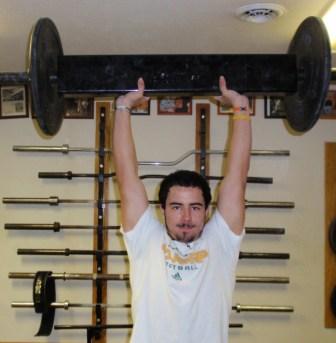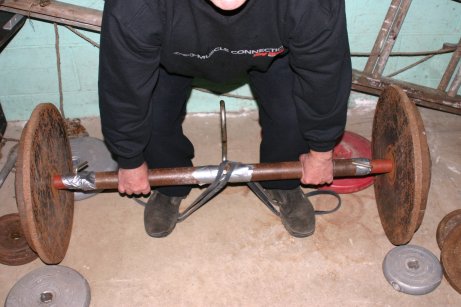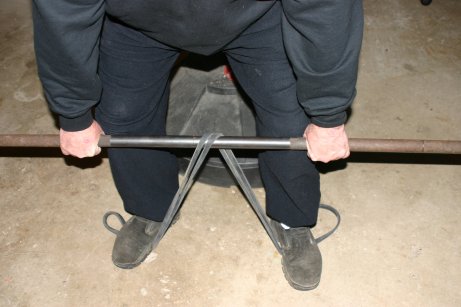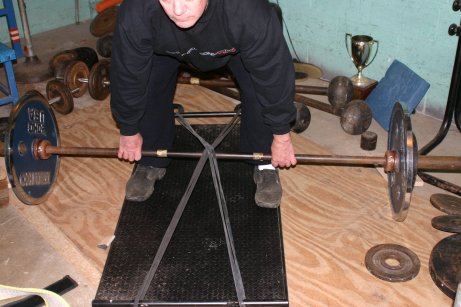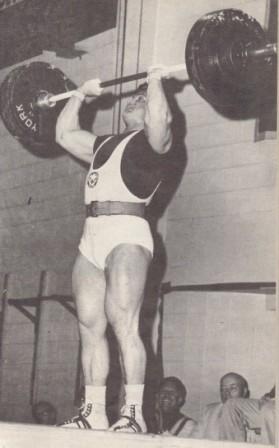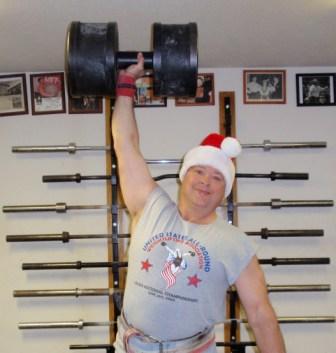by Al Myers
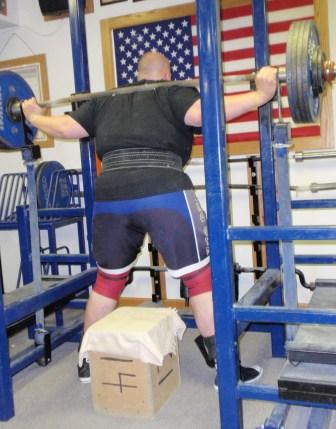
Scott Tully, of the Dino Gym, reps out a set of 8 with Band Squats (450 pounds on the bar, plus 150 pounds added band tension at the lockout).
John McKean’s recent USAWA Daily News story about how he uses bands in training got me thinking about one of the biggest uses of JumpStretch Bands in the Dino Gym. Bands are VERY beneficial in adding resistance to many different exercises – but I believe the best exercise they “assist” is the squat. This is nothing new as Louie Simmons of Westside Barbell has been preaching the benefits of bands for many years now! However, we have a band set-up for squats that is very unique, and something I would like to share with other lifters. First of all, there are two DISTINCT ways bands may be attached to a squat bar. One is overhead, where the band tension is added at the BOTTOM of the squat. The other is at the base, where band tension is added at the top of the squat, or at lockout. Both have there uses, but after experimenting with both set-ups I prefer the bands to be attached LOW, so as you ascend out of the bottom of a squat the bands stretch and give you added resistance at the lockout. I think it is best for the bands to go completely “slack” as you hit the bottom squat position and “kick in” immediately after initial ascent. I like the feeling of “pushing against” the bands instead of the bands “pulling you up”. I feel good squat technique is ENHANCED when “pushing against” the bands. By the weight on the bar being lighter in the bottom position, it allows you to maintain good form in keeping your hips back and shoulders up. By starting in the correct position, you are better able to maintain good form throughout the rest of the squat. Another reason I like the bottom attachment is that it just doesn’t seem right to me to use bands to make an exercise easier!
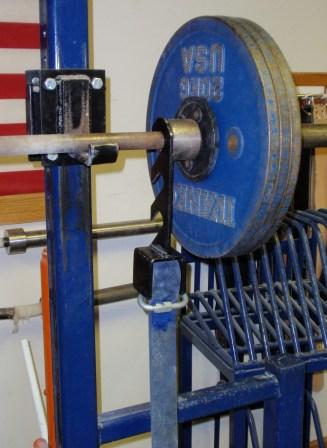
The top 3-prong hook band attachment, which has three different bar attachment points to adjust band tension for lifters of different heights.
Much has been written about what is the best tension at the top position, or lockout. I feel around 25% added resistance (compared to bar weight) with bands is about right. This can be accomplished with two Blue JumpStretch Bands, one attached on each side. Others have different opinions on this. When I designed a band attachment set-up for the Dino Gym Monster Cage, several things I wanted to achieve. First, I wanted an easy set up that could be changed quickly between lifters who may be of different heights while maintaining the same band tension at the top end for everyone. Second, I wanted a band set-up that would “roll” out with the lifter as they set up for the squat to make band squatting safer. Most band attachments on cages have a distinct concrete points where they attach, which makes setting up for the squat difficult. Third, I wanted to make the band set-up to achieve a 150 pound “overload” at the top position (approximately 25% increase since most of the guys in the gym squat over 600 pounds). I spent a little time thinking of these problems, and designed a set-up that solves all of them! We have been using this band attachment set-up for several years now and couldn’t be happier!
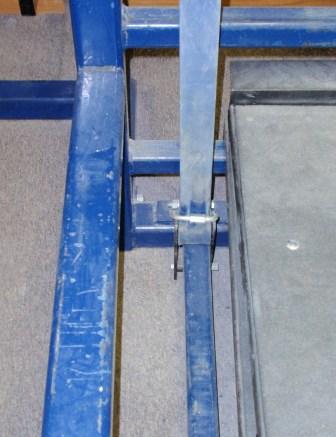
The bottom band attachment. Notice the roller the band attaches to that "rolls back" as the lifter sets up for the squat.
The bottom attachment problem was solved by attaching the bands to a roller that “rolled back” as the lifter steps back with the bar on the back. The problem of attaching the bands to the bar was solved by designing a 3-prong hook which could easily be “looped” over the bar next to the inside sleeves not interfering with hand placement. It can easily be changed between lifters. Our Monster Cage has bar hooks that adjust with hydraulic jacks so each lifter can have an optimum start height. This allows all gym members, regardless of height, to be able to work out together. We can change the bar height and re-adjust the band hookup in less than 30 seconds. The length between each three-prong band hook was initially based on the heights of three gym members – Lon at 5’7″, myself at 6 foot, and Scott at 6’5″. Lon uses the bottom hook, myself the middle hook, and Scott the top hook. Each hook set-up yields EXACTLY 150 pounds added band tension at the top! It couldn’t work out any better than that!!
I hope these ideas will help others in properly setting up a band attachment for their squat training. If anyone has more specific questions, please contact me a amyers@usawa.com
